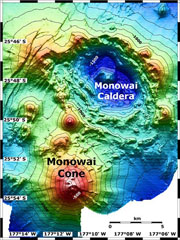Report on Monowai (New Zealand) — May 2003
Bulletin of the Global Volcanism Network, vol. 28, no. 5 (May 2003)
Managing Editor: Edward Venzke.
Monowai (New Zealand) Volcanic earthquake swarm April-May detected by T-waves
Please cite this report as:
Global Volcanism Program, 2003. Report on Monowai (New Zealand) (Venzke, E., ed.). Bulletin of the Global Volcanism Network, 28:5. Smithsonian Institution. https://doi.org/10.5479/si.GVP.BGVN200305-242050
Monowai
New Zealand
25.887°S, 177.188°W; summit elev. -132 m
All times are local (unless otherwise noted)
Monowai is a frequently active submarine volcano, with a volcanic swarm recorded in November 2002 (BGVN 28:02) and another during April-May 2003. A major part of its volcanic activity is detected by hydro-acoustic waves (also called T-waves) generated during the eruptions, through the Réseau Sismique Polynésien (RSP), the French Polynesian seismic network (table 1).
Table 1. Seismic station codes and coordinates of instruments in the French Polynesian seismic network. Courtesy of RSP.
| Station code | Latitude | Longitude |
| PAE | 17.6619°S | 149.5800°W |
| PPT | 17.5682°S | 149.5761°W |
| PPN | 17.5308°S | 149.4322°W |
| TIA | 17.5578°S | 149.3458°W |
| VO | 17.7825°S | 149.2517°W |
| MEH | 17.8753°S | 148.0661°W |
| PMOR | 15.0017°S | 147.8942°W |
| VAH | 15.2364°S | 147.6272°W |
| TBI | 23.3489°S | 149.4608°W |
| RKT | 23.1197°S | 134.9733°W |
A strong volcanic swarm located on the Monowai seamount was recorded during April-May 2003 (figure 13). This volcanic swarm was very well located around Monowai, using the inversion of the arrival times of T-waves recorded by the network. As an example of the precision of location, with the contribution of some IRIS stations like RAR (Cook Island) to enlarge the array dimension, the ellipse of error can typically be 13 km on the major axis and 2 km on the minor axis, with a Root Mean Squared (RMS) of 0.25 s.
 |
Figure 13. T-wave amplitude versus time for the TVO seismic station, showing the three distinct and well separated episodes of the Monowai Seamount swarm. Courtesy of RSP. |
This volcanic swarm was composed of three episodes lasting 4-5 days each. It started suddenly on 10 April 2003 with a rate of 100 events per day (about one signal every 10 minutes) and reached a maximum intensity later that day. The average rate over the first four days was 75 events per day (300 signals between 10 and 14 April), but the number of events detected is thought to be underestimated by a factor of at least 3 to 5 because only the main packets of recorded T-waves were picked. Volcanic activity started again during 19 April, with 120 events recorded in the next five days. The last episode occurred between 3 and 6 May, with ~100 volcanic signals recorded. The swarm ended as suddenly as it started.
Geological Summary. Monowai, also known as Orion seamount, is a basaltic stratovolcano that rises from a depth of about 1,500 to within 100 m of the ocean surface about halfway between the Kermadec and Tonga island groups, at the southern end of the Tonga Ridge. Small cones occur on the N and W flanks, and an 8.5 x 11 km submarine caldera with a depth of more than 1,500 m lies to the NNE. Numerous eruptions have been identified using submarine acoustic signals since it was first recognized as a volcano in 1977. A shoal that had been reported in 1944 may have been a pumice raft or water disturbance due to degassing. Surface observations have included water discoloration, vigorous gas bubbling, and areas of upwelling water, sometimes accompanied by rumbling noises. It was named for one of the New Zealand Navy bathymetric survey ships that documented its morphology.
Information Contacts: Dominique Reymond and Olivier Hyvernaud, Laboratoire de Geophysique, CEA/DASE/LDG Tahiti, PO Box 640, Papeete, French Polynesia.

